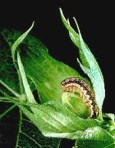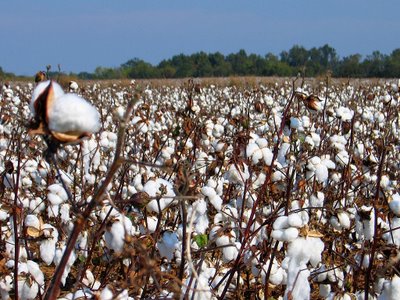Genetically Modified cotton, another production by Monsanto, claims 83% of the GM market. And like other GMO’s this cotton variety produces its own pesticide. Bt cotton is Roundup Ready cotton genetically modified to resist the herbicide glyphosate. Bt stands for Bacillus thuringiensis, a bacteria that comes from soil. The Bt gene is inserted into the cotton seed ( the Monsanto gene gun at work, AGAIN,) and it produces its own Bt toxin. This Roundup Ready  cotton is planted by the farmers, and then sprayed with the Roundup containing glyphosate. The plants could withstand this spraying while the weeds died. BUT….
cotton is planted by the farmers, and then sprayed with the Roundup containing glyphosate. The plants could withstand this spraying while the weeds died. BUT….
As it goes with GMO’s, something went WRONG. Nature’s inherent desire to survive kicked in and the weeds fought back. The weeds became resistant to the glyphosate in Roundup and many other types of herbicides. Super-weeds came, and next the super-bugs!
The Bt variety was introduced in the US in 1996. That was Monsanto’s banner year. Many of the GMOs were introduced in this year. And I might add, without proper testing to ensure their safety. They dumped a massive load of untested, pesticide producing seeds, right in our food chain. All done with a handshake and a smile from the FDA. 😦
India was heavily impacted by the introduction of the commercially sold Bt cotton in 2002. These farmers were promised gold. Instead many of them became paupers.
 Bollworm pests caused crop failure and major economic losses to these farmers, even though they were told that the cotton had a built-in pesticide that would resist the bollworm.
Bollworm pests caused crop failure and major economic losses to these farmers, even though they were told that the cotton had a built-in pesticide that would resist the bollworm.
90% of India’s farmers grew this genetically modified variety of cotton; followed by big promises from “you know who.” 
Sadly the farmers response to this failure was the worst imagined. Many farmer suicides were found to have been caused by the failure of these crops; beginning only 3 years after their introduction. Monsanto and its seed monopoly coupled with crop failure, and the high cost of seeds and chemicals were the “seeds of suicide.”
Nations of Change reports that “Monsanto’s cost-inflated and ineffective seeds have been driving farmers to suicide for quite some time, and is considered to be one of the largest — if not the largest — cause of the quarter of a million farmer suicides over the past 16 years.”
In three years these Bt genes began to wreak havoc on the soil. according to Global Research, “In 3 years, Bt-cotton has reduced the population of Actinomycetes (a bacteria) by 17%. Actinomycetes are vital for breaking down cellulose and creating humus (soil produced by decomposition). Bacteria were reduced by 14%. The total microbial biomass or the living part of the soil, organic matter, was reduced by 8.9%.”
They also found that “vital soil beneficial enzymes which make nutrients available to plants have also been drastically reduced. Acid Phosphatase, which contributes to the uptake of phosphates was reduced by 26.6%. Nitrogenase enzymes which help fix nitrogen were reduced by 22.6%. The planting with GM cotton, or any GM crop with Bt genes in it, could lead to total destruction of soil organisms, leaving dead soil unable to produce food.” Global Research
So besides being ineffective at killing pests, the Bt genes were destroying the soil and any possibility for future growth. A study performed in India concluded that “the long-term impact of Bt cotton on soil organisms is a wake up to regulators worldwide. It also shows that the claims of the Biotechnology industry about the safety of GM crops are false.”
For a copy of that report you can go to: http://www.navdanya.org/
Livestock die after grazing in Bt cotton fields, others fall sick. Read more here: Bt Cotton and Livestock: Health Impacts, Bio-safety concerns and the Legitimacy of Public Scientific Research Institutions by Dr Sagari R Ramdas (Director, Anthra)
The Institute for Responsible Technology, one of the most comprehensive sources for GMO health risks, cite problems related to exposure to Bt cotton:
Workers exposed to Bt cotton developed allergies
1. Agricultural laborers in six villages who picked or loaded Bt cotton reported reactions of the skin, eyes and upper respiratory tract. 2. Some laborers required hospitalization. 3. Employees at a cotton gin factory take antihistamines everyday. 4. One doctor treated about 250 cotton laborers
Sheep died after grazing in Bt cotton fields
1. After the cotton harvest in parts of India, sheep herds grazed continuously on Bt cotton plants.
2. Reports from four villages revealed that about 25% of the sheep died within a week.
3. Post mortem studies suggest a toxic reaction.
Dreaded Skin Affection seen above has become common in people working in BT cotton farms. This photograph shows a 60-year-old farm labourer Mr Ram Singh of Village Agroha, (District Hisar, India) being affected by unknown skin disease due to BT cotton. (savefarmer.info)
Are We Being Exposed???
The answer is YES! Approximately 93% of the cotton produced in 2010 in the US is genetically modified. Because of the heavy pesticide use, it is considered “one of the world’s most dirtiest crops.”And although cotton is a fiber, its seeds are used for food items and feed, and sadly is on the market.
- Oil: the high-quality cotton seed oil is utilized for cooking and deep-frying, as well as in
 margarine,
margarine, - Whole grain: the albuminous pellet (the endosperm) is used primarily for feed–cotton seed meal. It is also a base for protein compounds and isolates, as well as for cotton seed milk.
- ‘Linters’: These very short, non-textile fibres cling to the cotton seeds. They consist almost exclusively of cellulose. Various food additives such as thickening agents, stabilizers, emulsifiers or fillers are made from these. http://farmwars.info/?=6920 Be mindful humans can’t break down or digest cellulose.
Other ways we are exposed to Bt toxin in cotton:
- Bed sheets, towels, cotton clothing, socks, diapers;
- “our skin absorbing more than 60% “of what we come in contact with. http://www.organicauthority.com/
- Cotton balls, Q-tips, tampons, and sanitary napkins, paper towels, toilet paper

 Here’s an interesting note from Consciouslifenews.com
Here’s an interesting note from Consciouslifenews.com
“Sixty five percent of conventional cotton production ends up in our food chain, directly through food oils or indirectly through the milk and meats of animals feeding on cotton seed meal and cotton gin by-products. The hazardous effect of conventional cotton in our food chain comes from GMO and Bt cotton by-products, which are generated from manufacturing non-food cotton products. These by-products are commonly known as “Gin Trash” which consists of cotton seed, stalk, leaves, burrs, twigs, dirt and everything else that are not used in cotton textile production. The “Gin Trash” is sold to food companies to undergo further processing to create cotton seed oil, additional additives and fillers in processed foods for livestock feed, and soil compost mix. Additionally, the waste from the processing goes directly into our water supply.“
The chemicals in cotton are very toxic and they do cause an array of health problems. All Natural is Not Natural, so read your labels and demand Certified Organic Cotton. Those chemicals are still there even after washing. Cottonseed oil is found in many processed foods. Avoid it! The same goes for margarine. Healthy oils include olive, coconut, avocado, walnut, and grape-seed, preferably Organic.
If we all stand together against the evil corporations, boycotting the manufacturers and the sellers; we can send the message that We SAY NO to YOUR GMO and WE MEAN NO!!!
sellers; we can send the message that We SAY NO to YOUR GMO and WE MEAN NO!!!
Choose Brands without GMOs.
“Just a small percentage of the population switching to non-GMO brands will create a tipping point, forcing major food companies to quickly replace GM ingredients. When the tipping point of consumer rejection was reached in Europe in 1999, within a single week, virtually all major food companies committed to remove GMOs.” quote courtesy of the Institute of Responsible Technology, Jeffrey Smith
Sharing is Caring. Talk to you later friends…



Yep. Well said, great article. Teach the children…
LikeLike
Yes, my friend. We both are teaching. Thanks!!!
LikeLiked by 1 person
Reblogged this on urright2no and commented:
Sharing is caring!
LikeLike